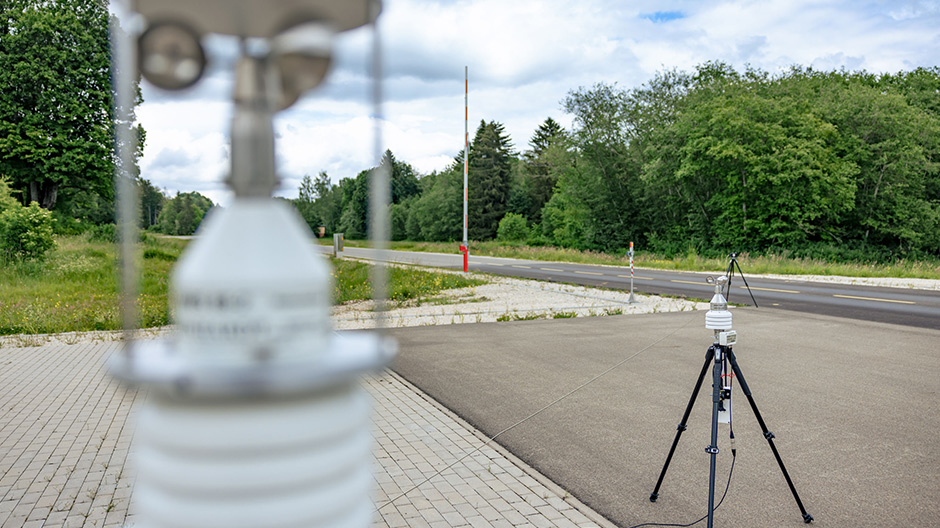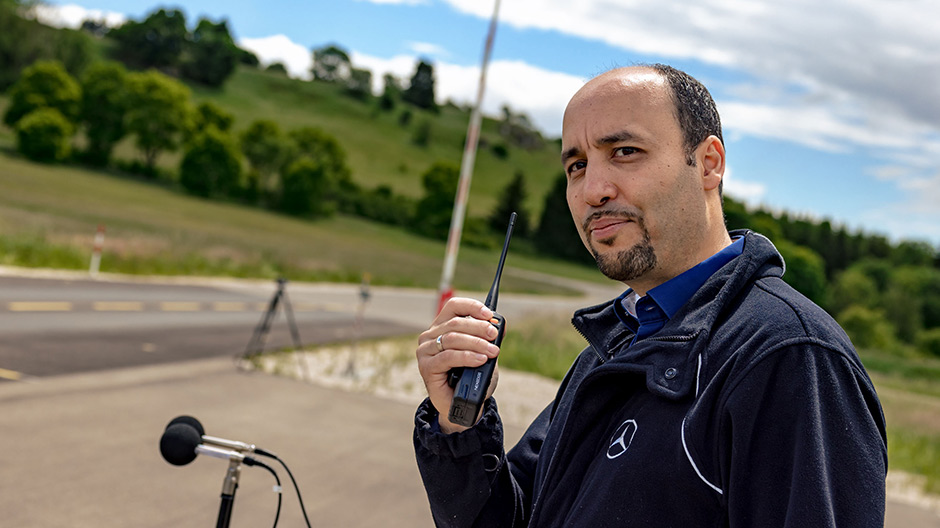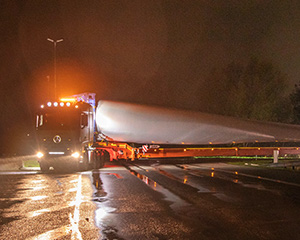
Why the eActros can – and must – make noise
Feature
Noise expert Dr Kamal Idrisi ensures a safe sound from the eActros. A visit to the noise measuring track in Münsingen, Baden-Württemberg.

Workshop employee Sebastian Theobald (left) puts his foot down in the eActros at Dr. Kamal Idrisi's signal.
Münsingen, a former military training area in the Swabian Jura. Birds singing, crickets chirping, a gentle breeze blowing across the beautiful landscape. Aside from that, you hear nothing. The perfect environment for Dr. Kamal Idrisi, Team Leader for Exterior Noise at Daimler Truck AG and his employees. For what? To measure the eActros' noise. And to check whether the legally mandatory limits are complied with. "All of this has to be tested. Our test track in Münsingen is ideal for this because there is no traffic or other noise and only very little external noise," explains Dr Idrisi. "That's a rarity."
This article contains additional material (videos, images and reports etc.) for registered RoadStars members. In order to experience the article to the full, you need to log in with your RoadStars account or register for one free of charge.
Become a RoadStar and gain access to exclusive content and campaigns!
Login for RoadStars members
Not yet a member? Join RoadStars now
Obtain exclusive access to exciting events and activities which only RoadStars can offer.
Join RoadStarsKey topic: Safety.
In terms of volume, all vehicles must meet both minimum and maximum external noise requirements. Electric vehicles, which can be extremely quiet, sometimes do not meet these requirements at low speeds of up to 20 kilometres per hour. "A quiet vehicle like the eActros becomes almost invisible in terms of noise, especially in the city," says Idrisi. A safety risk. The EU Directive on the safety of electric and hybrid vehicles, "UN ECE R 138.1", specifies when artificially generated sound, the AVAS (Acoustic Vehicle Alerting System), is required.

AVAS in the eActros. One loudspeaker is located at the front and one at the rear of the vehicle.
The AVAS sound.
Workshop employee Sebastian Theobald brings an eActros onto the ISO-certified measuring track in Münsingen, which is around 500 metres long. How do pedestrians perceive the eActros in terms of volume? “We can differentiate basic vehicle noises, such as acceleration and deceleration, on the eActros via the AVAS by increasing or decreasing the pitch, depending on the speed,” explains Dr Idrisi. From a speed of 20 km/h, the tyre-road noise is added, which automatically increases the noise level. Idrisi adds: “Mercedes‑Benz Trucks pays particular attention to the safety issue. We therefore place significantly higher demands on the AVAS installed in the eActros than are required by law.”

The eActros already "announces itself" when stationary.
„The AVAS installed in the eActros meets significantly higher criteria than required by law.“
– Dr Kamal Idrisi, Exterior Noise Team Leader at Daimler Truck AG
A weather station, light barriers and microphones are available at the measuring point. The microphones are two metres away from the centre of the road – just like pedestrians on the side of the road. Connection cables transmit the signals to the control room, a small structure with a pointed front, "so that the sound is deflected and not reflected onto the road surface," explains Idrisi. "This means that the measured values are not distorted." The strength of the sound, the volume, is measured in decibels. How much the ear perceives the volume is expressed in dB(A).





A sound is created.
How exactly does it produce its forward sound, i.e. the sound when stationary and building up to a speed of 20 km/h? "We used the Mercedes‑Benz car sound as the basis for the AVAS in the eActros," explains Dr Idrisi. For the basic sound, a roar-like noise component is mixed with a sound and played through the front speaker depending on the speed. "It is important that the sound is good and represents the Mercedes‑Benz brand to the outside world," says Idrisi. After preliminary tests, we went to the measuring track in Münsingen. Daimler experts put the system through its paces.

Prototypes of the eActros 600 are also being tested at the testing site in the Swabian Jura. The electric, long-haul truck must be ready for series production in 2024 and have a range of around 500 kilometres without opportunity charging.
The sound for driving forwards comes from a loudspeaker with an integrated control unit. "It sounds something like a faint fan noise. This is not perceived by the driver as artificial or disruptive, but rather blends harmoniously into the surroundings." Plus: the eActros can be heard even when stationary. "This was a safety criterion for us, as a blind pedestrian, for example, can hear a truck that is stationary but ready to drive."


Which other requirements must be met on the noise measurement track? "In fact, when the road surface is wet, the tyre-road noise can dominate the vehicle and also the AVAS. For the statutory test, the road surface must therefore be dry in order to test the vehicle with low tyre-and-road noise." A vehicle equipped with AVAS must generate at least 50 dB(A) (soft radio music) at a speed of 10 km/h and 56 dB(A) (radio music at room volume) at 20 km/h.

A quiet patch: the noise test track in the Swabian Jura.
And what is the future of sound development for the eActros? According to Dr Idrisi there is a lot of customer feedback. "We will of course incorporate these findings into future AVAS developments."
Photos and video: Alexander Tempel




Comment
Please log in to post a comment.
9 comments
Kann mir jemand Auskunft geben, ab wann die Akkus gewechselt werden müssen und wie diese weiterverwendet bzw. entsorgt werden?
Ein interessanter Artikel und ein tolles Video.
👍👍👍👍🚛😎🙋♂️
Kann mir jemand Auskunft geben, ab wann die Akkus gewechselt werden müssen und wie diese weiterverwendet bzw. entsorgt werden?
Ein interessanter Artikel und ein tolles Video.
👍👍👍👍🚛😎🙋♂️
Die Batterien sind ganz klar ein wichtiges Thema. Beim eActros 600 zum Beispiel sind sie auf zehn Jahre beziehungsweise 1,2 Millionen Kilometer Laufleistung ausgelegt. Da hat es mit dem Recycling also noch etwas Zeit, die wir nutzen, um weiter an möglichst wirtschaftlichen und nachhaltigen Lösungen zu feilen. Nicht vergessen: Die Entwicklung bleibt ja nicht stehen, sondern geht immer weiter!
Die Batterien sind ganz klar ein wichtiges Thema. Beim eActros 600 zum Beispiel sind sie auf zehn Jahre beziehungsweise 1,2 Millionen Kilometer Laufleistung ausgelegt. Da hat es mit dem Recycling also noch etwas Zeit, die wir nutzen, um weiter an möglichst wirtschaftlichen und nachhaltigen Lösungen zu feilen. Nicht vergessen: Die Entwicklung bleibt ja nicht stehen, sondern geht immer weiter!
👍👍👍👍🚛😎🙋♂️
👍👍👍👍🚛😎🙋♂️